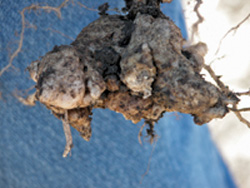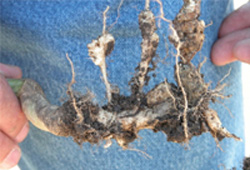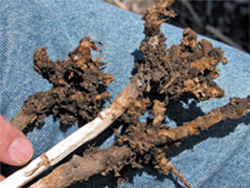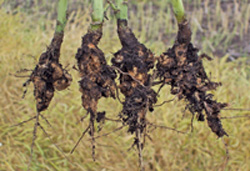
Features
Agronomy
Diseases
A serious disease threatens central Alberta
In just three years, clubroot disease in canola has already become established.
November 29, 2007 By Carolyn King
The 2003 identification of clubroot in canola in the Edmonton area was a first.
Although the disease occurs in cruciferous vegetables in Canada and in cruciferous
crops including oilseed rape in Europe and Australia, it had never before been
identified in prairie canola fields. Unfortunately, this long-lived, soilborne
pathogen seems to be thriving in its new home.
 |
| A canola root with a severe clubroot infection. Photo Courtesy Of Kelly Turkington. |
With no strong options for controlling the disease once it is in a field, Alberta
canola growers are being encouraged to take preventive measures and researchers
are starting on the task of determining how to manage this potentially devastating
disease in prairie canola fields.
Clubroot is caused by Plasmodiophora brassicae Woronin. This pathogen
is a protist, an organism with plant, animal and fungal characteristics. It
infects plant roots, causing galls to form. These galls prevent water and nutrients
from getting to the rest of the plant. When the galls decay, they leave millions
of resting spores waiting patiently in the soil to infect new host plants.
"The worst characteristic about clubroot is that it is very long-lived,"
explains Paul Laflamme, a pest risk management specialist with Alberta Agriculture,
Food and Rural Development (AAFRD). "We deal with all kinds of organisms,
whether they are fungi or bacteria or viruses or protists. For most of them,
the overwintering forms live perhaps three or four years and some live only
one year. But research in Europe indicates that clubroot resting spores can
live in the soil for 15 to 20 years in the absence of a host."
The Edmonton region, along with much of the rest of Alberta's canola-growing
lands, has conditions that favour clubroot. It must have moisture to infect
a plant, and it prefers acidic conditions and warm soils between 20 and 24 degrees
C. "Most of the soils around the Edmonton area are acidic, below pH 7.
We get fairly good rainfall in this area, so there is enough free water around
in some years, although not all years, for the pathogen to be able to complete
its life cycle and cause the disease," notes Laflamme.
Dr. Stephen Strelkov of the University of Alberta and Ralph Lange of the Alberta
Research Council have been collaborating on surveys of clubroot in canola since
it was first identified. In 2003 and 2004, they did small surveys, limited mainly
to fields in and around Sturgeon County, where the disease was first identified.
In 2003, they found clubroot in a handful of canola fields. Due to dry conditions
in 2004, they did not find any diseased plants. In 2005, a wetter year, they
expanded the survey to about 150 fields in several counties around Edmonton
and in the acid soils of east central Alberta. They found the disease in about
40 fields.
Strelkov says, "Initially we didn't know whether the outbreak was just
an isolated pocket, but in 2005 we found that clubroot was very widely distributed
in Sturgeon County. We also found a diseased field in Leduc County and we've
had reports that there were at least a few more infested fields there. We also
found an infested field in the county of Wetaskiwin and one in the Killam area,
which is some distance away from the main outbreak." They are hoping to
get an even better idea of the actual distribution of the infestation in 2006.
What to look for, what to expect
Symptoms of the disease include premature ripening, wilting, yellowing, stunted
growth, seed shrivelling and galls on the roots. The symptoms sometimes look
similar to those for such conditions as heat stress, drought stress, sclerotinia
stem rot or fusarium wilt.
 |
| A canola root with moderate clubroot galls. Photo Courtesy Of Kelly Turkington. |
To distinguish clubroot from these other problems, look for the whitish galls
on the roots. Laflamme says, "The galls can range in size from almost nothing
to nearly an onion size, where the whole root is one big gall." When the
galls decay late in the season, they have a brown, peaty appearance.
Laflamme says, "We haven't done any research yet to measure canola yield
losses in Alberta, but based on research in Europe, they estimate that if you
have a 50 percent infection, you can expect about a 25 percent yield loss, so
about half of whatever your infection level is. That's very similar to a disease
like sclerotinia."
He adds, "Just from observation, it seems that if the infection occurs
later in the year, there's not as much of an effect on yield as if the infection
is earlier in the year. So yield loss will depend on when the infection occurs
and that depends on when there's enough free water in the soil for the organism
to be able to infect."
Clubroot also affects crop quality. Laflamme says, "Because the galls
cut off the flow of water and nutrients to the plant, the plant is not able
to finish developing properly, so you don't get as many pods and the seed tends
to be smaller."
An ounce of prevention
Right now, controlling the disease once it is in a field is very difficult.
With the pathogen's ability to live without a host plant for so many years,
crop rotation does not offer a practical way to control the disease. No fungicides
are registered for use against it in canola and no resistant canola varieties
have been identified, yet. Strelkov notes, "We did some screening and we
found that there was no difference between Argentine and Polish canola, at least
in the varieties we tested. Both types were very heavily infested."
For producers, the key at present is to prevent the spread of clubroot into
new fields. Cleaning off your equipment between fields is the most important
measure.
Laflamme says, "If a farmer is working on one field, picks up his equipment
and moves to the next field and there is infected soil on that equipment, he
can infect another field with it. We think that's how the disease has been spreading.
Especially if you know a field is infested, take that extra five minutes to
knock the dirt off your equipment before you move to the next field."
AAFRD is giving that same advice to others who move equipment from field to
field, like oilfield companies and custom applicators. Laflamme adds, "If
there is a company crossing your land, putting in a pipeline, for example, explain
the situation to them. Most of them will do what they can to help minimize the
problem."
Although knocking the soil off is a good first step, it is almost impossible
to remove all the soil from equipment that way. Using a pressure washer provides
a more thorough cleaning, but for most producers that is not practical.
Other preventive measures include: minimizing soil erosion; avoiding common,
untreated seed; avoiding straw from infested areas; avoiding manure from animals
that have eaten feed from infested fields; and increasing the length of the
rotation away from canola and other susceptible crops for at least four years.
Susceptible crops include other cruciferous crops such as mustard, cabbage,
cauliflower and turnip, as well as cruciferous weeds and a few other crops like
orchardgrass, red clover and perennial ryegrass. A longer rotation will not
prevent the disease, but it might slow it down.
 |
| Decaying clubroot galls on a canola root. Photo Courtesy Of Kelly Turkington. |
First steps in the fight against clubroot
Researchers, specialists and extension agents have been busy since the disease
was found in canola in 2003. AAFRD has produced a fact sheet, called Clubroot
Disease of Canola and Mustard, and a poster. Laflamme and other AAFRD specialists
have been doing news media interviews and giving presentations across the province
and partner agencies, like the Canola Council of Canada, are also spreading
the word about the disease.
"We are also in discussions to possibly have clubroot added to Alberta's
Agricultural Pests Act as a declared pest. Then we would have a way of enforcing
people, including oilfield companies, to clean their equipment before they move
from field to field," notes Laflamme. Adding a pest to the Act requires
stakeholder consultations and consensus on the issue, so the process can take
some time.
On the research side, Strelkov has done some preliminary work to better understand
the disease. These initial investigations suggest the disease could be a very
serious concern for canola growers.
He says, "It's such a new disease, we really don't know too much about
it here on the prairies. One thing we do know is that the scale of the infestation
here could potentially be much greater than in Europe in the sense that here
we are dealing with quarter sections, while in Europe the fields are smaller
and the disease tends to occur mainly on cruciferous vegetables. Last year,
for instance, we had seven or eight canola fields here that were essentially
completely infested. So the inoculum potential is huge in terms of the amount
of spores that would be produced on that entire quarter section.
"We've also been testing the pathotypes, or strains of the pathogen, that
we have here. Clubroot has occurred for many years in other parts of Canada,
mainly in cruciferous vegetables. So we compared the strains we have here to
the strains, for instance, from Ontario and British Columbia. Those other strains
can attack cruciferous vegetables like cabbage and produce a lot of disease,
but they do not attack canola very well. The strains we have here can still
attack the vegetables, so we think they were introduced here through cruciferous
vegetables. But they apparently have evolved through selection pressure and
are also very virulent on basically all the canola varieties that we have available.
So the pathogen has really jumped from vegetables into canola."
Strelkov continues, "The other thing is (in other regions and in other
crops), clubroot usually occurs in patches. So we were quite surprised to find
about a quarter of the canola fields in 2005 where the disease had spread throughout
the entire field quite evenly."
On the bright side, Strelkov recently developed a quick and easy diagnostic
technique for clubroot. This method, based on DNA analysis, can identify even
very small amounts of the clubroot resting spores in soil and plant samples
within a few hours. Previously, the diagnosis methods were based on growing
susceptible seedlings in the possibly infected soil and then waiting to see
whether clubroot symptoms appeared, which can take at least three to six weeks.
 |
| Clubroot infections. Photo Courtesy Of Tiesen Cao. |
Strelkov is hoping to obtain additional funding for research in the coming
year to begin developing management practices for clubroot in canola. He says,
"Really, no work has been done on managing clubroot under our prairie conditions
and certainly not on canola in the prairies. So we hope to look at different
treatments that have worked either on cruciferous vegetables or on oilseed rape
in northern Europe, and try to adapt them to see how effective they would be
under our conditions, to develop a whole package that farmers could use for
managing clubroot on their land."
If you suspect that you may have clubroot in canola, you can send root samples
to Strelkov at the University of Alberta or to Lange at the Alberta Research
Council. If possible, the root sample should have a bit of soil attached and
the sample should be in a paper bag, rather than a plastic bag.
The test results from the sample could help both you and the researchers. If
the diagnosis of clubroot is confirmed, then it is especially important to clean
the soil off your equipment before leaving the infected field. For researchers,
the information will help them get a better handle on the pathogenÕs distribution
and its pathotypes.
Strelkov explains, "We're trying to get a feel for how much diversity
there is in the pathogen because that will be important in breeding canola varieties
for resistance. If you grow a resistant canola cultivar but the population of
pathogen is very diverse, then the pathogen can evolve more quickly, break down
that resistance and be able to attack the plant. If it is less diverse, then
resistance can last longer."
He adds, "But I think any sort of genetic resistance will have to be used
within the context of an integrated disease management system. Providing a proper
rotation, proper nutrition, good quality seed and so on, combined with resistant
varieties, will ensure that resistance can last a longer time."
For now, Laflamme and Strelkov recommend that Alberta canola growers be on
the lookout for the disease and remove as much soil as possible from their equipment
between fields. Strelkov emphasizes, "Once the soil is infested, it is
almost impossible to get rid of clubroot. That land becomes infested, essentially
forever."